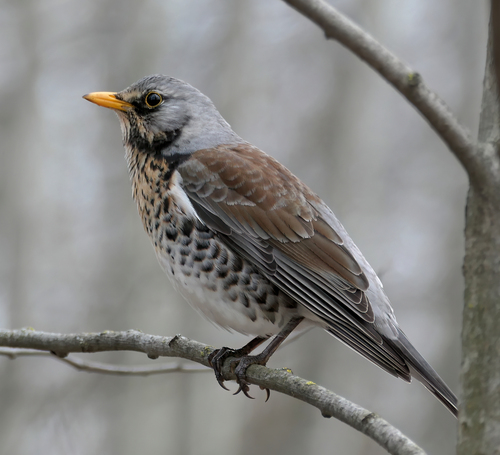
Fieldfare
The Fieldfare (*Turdus pilaris*) is a striking member of the thrush family, known for its bold, upright stance and distinctive, chattering calls. These birds are highly social, often seen in large flocks, particularly during winter migrations. They play an important ecological role as seed dispersers and consumers of invertebrates, contributing to the health of woodland and agricultural ecosystems. While not typically associated with strong cultural symbolism, their arrival in large numbers is often considered a harbinger of winter in many parts of Europe.
25-28 cm
Length
39-42 cm
Wingspan
Least Concern
Conservation Status
Distribution
The Fieldfare breeds across northern Europe and Asia, extending from Scandinavia and eastern France eastward to Siberia. During winter, they migrate south and west, reaching the British Isles, southern Europe, North Africa, and the Middle East. They have a broad altitudinal range, from lowlands to mountainous regions.
Lifespan
Typically 3-5 years in the wild, but can live longer.
Fieldfare's Habitat
Habitat Types
Woodlands, Farmlands, Parks, Gardens, Hedgerows
Climate Zones
Temperate, Boreal
Adaptations
Fieldfares are adaptable to a range of habitats, showing a preference for areas with a mix of open ground for foraging and trees or shrubs for nesting and roosting. Their robust build allows them to withstand cold temperatures during their winter migrations.
Variations
No clearly defined subspecies are generally recognized, although some variations in plumage coloration and size may occur across their extensive range.
Appearance
Breeding Plumage
Plumage is similar year-round, although it may appear slightly brighter during the breeding season.
Seasonal Feather Changes
Subtle changes, with breeding plumage appearing slightly brighter.
Sex Based Plumage Differences
Minimal. Males and females have similar plumage.
Notable Features
Grey head and rump, Chestnut-brown back, Black tail, Heavily speckled breast and flanks
Diet and Feeding
Primary Foods
Invertebrates (earthworms, insects, snails), Berries, Fruits, Seeds
Foraging Behavior
Fieldfares forage primarily on the ground, hopping and running to search for prey. They often probe the soil with their bills to find earthworms and other invertebrates. They also feed in trees and shrubs, particularly on berries and fruits.
Specializations
Their strong legs and bill are well-suited for ground foraging. They can also form large flocks to help locate and exploit food resources.
Seasonal Diet Variations
During the breeding season, their diet is dominated by invertebrates. In autumn and winter, they shift to a diet rich in berries, fruits, and seeds.
Behavior
Social Structure
Highly social, especially outside the breeding season. They form large flocks, sometimes numbering hundreds or even thousands of birds, during migration and winter.
Communication
Loud, chattering calls ('chack-chack'), A thin, high-pitched 'seeh' call, A complex song during the breeding season
Migration
Fieldfares are migratory, with northern populations moving south and west for the winter. Migration is often triggered by cold weather and food scarcity. They are known for their nomadic movements in winter, searching for areas with abundant food.
Territorial or Group Behaviors
During the breeding season, they defend nesting territories. Outside the breeding season, they are highly gregarious and form large flocks for foraging and roosting.
Conservation
Threats
Habitat loss (particularly loss of hedgerows and traditional orchards), Climate change (affecting food availability and breeding success), Intensification of agriculture (reducing invertebrate prey)
Protection Programs
Habitat restoration and management initiatives, Agri-environment schemes promoting wildlife-friendly farming practices
Local National Laws
Protected under various national and international wildlife legislation, such as the EU Birds Directive.
Population Trend
Stable
Population Estimates
The global population is estimated to be in the tens of millions.
Interesting Facts
Fieldfares are known for their aggressive defense of their nests.
They will mob potential predators, such as crows and birds of prey, and even defecate on them as a defense mechanism.
They often form mixed flocks with other thrush species, such as Redwings.
This mixed flocking behavior may provide benefits in terms of foraging efficiency and predator avoidance.
The name 'Fieldfare' is believed to derive from the Anglo-Saxon word 'feldware'.
Meaning 'traveller through the fields'.
Faqs about Fieldfare
What do Fieldfares eat?
Fieldfares have a varied diet. During the breeding season, they primarily eat invertebrates like earthworms, insects, and snails. In autumn and winter, they switch to berries, fruits, and seeds.
Where do Fieldfares nest?
Fieldfares build cup-shaped nests, usually in trees or shrubs. They often nest in loose colonies.
Are Fieldfares migratory?
Yes, Fieldfares are migratory birds. They breed in northern Europe and Asia and migrate south and west for the winter.
Are fieldfares rare?
No. Fieldfares are classified as 'Least Concern' by the IUCN. However, you're more likely to see them in the winter than the summer.
Copyright @ Nature Style Limited. All Rights Reserved.
 English
English